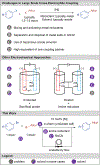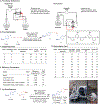Zinc-Free, Scalable Reductive Cross-Electrophile Coupling Driven by Electrochemistry in an Undivided Cell
- PMID: 37065181
- PMCID: PMC10101217
- DOI: 10.1021/acscatal.2c03033
Zinc-Free, Scalable Reductive Cross-Electrophile Coupling Driven by Electrochemistry in an Undivided Cell
Abstract
Nickel-catalyzed reductive cross-electrophile coupling reactions are becoming increasingly important in organic synthesis, but application at scale is limited by three interconnected challenges: a reliance on amide solvents (complicated workup, regulated), the generation of stoichiometric Zn salts (complicated isolation, waste disposal issue), and mixing/activation challenges of zinc powder. We show here an electrochemical approach that addresses these three issues: the reaction works in acetonitrile with diisopropylethylamine as the terminal reductant in a simple undivided cell (graphite(+)/nickel foam(-)). The reaction utilizes a combination of two ligands, 4,4'-di-tert-butyl-2,2'-bipyridine and 4,4',4''-tri-tert-butyl-2,2':6',2''-terpyridine. Studies show that, alone, the bipyridine nickel catalyst predominantly forms protodehalogenated aryl and aryl dimer, whereas the terpyridine nickel catalyst predominantly forms bialkyl and product. By combining these two unselective catalysts, a tunable, general system results because excess radical formed by the terpyridine catalyst can be converted to product by the bipyridine catalyst. As the aryl bromide becomes more electron rich, the optimal ratio shifts to have more of the bipyridine nickel catalyst. Lastly, examination of a variety of flow-cell configurations establishes that batch recirculation can achieve higher productivity (mmol product/time/electrode area) than single-pass, that high flow rates are essential to maximizing current, and that two flow cells in parallel can nearly halve the reaction time. The resulting reaction is demonstrated on gram scale and should be scalable to kilogram scale.
Keywords: cross-coupling; cross-electrophile coupling; electrochemistry; flow; mechanism; multimetallic catalysis; nickel.
Figures





Similar articles
-
Mechanism-Driven Development of Group 10 Metal-Catalyzed Decarbonylative Coupling Reactions.Acc Chem Res. 2022 Dec 6;55(23):3430-3444. doi: 10.1021/acs.accounts.2c00496. Epub 2022 Nov 16. Acc Chem Res. 2022. PMID: 36382937 Free PMC article.
-
Selective Ni-Catalyzed Cross-Electrophile Coupling of Heteroaryl Chlorides and Aryl Bromides at 1:1 Substrate Ratio.J Am Chem Soc. 2025 Jan 8;147(1):353-361. doi: 10.1021/jacs.4c10776. Epub 2024 Dec 23. J Am Chem Soc. 2025. PMID: 39714950 Free PMC article.
-
Nickel-Catalyzed Radical Mechanisms: Informing Cross-Coupling for Synthesizing Non-Canonical Biomolecules.Acc Chem Res. 2023 Dec 19;56(24):3640-3653. doi: 10.1021/acs.accounts.3c00588. Epub 2023 Nov 30. Acc Chem Res. 2023. PMID: 38033206 Free PMC article.
-
A Decade of Electrochemical Dehydrogenative C,C-Coupling of Aryls.Acc Chem Res. 2020 Jan 21;53(1):45-61. doi: 10.1021/acs.accounts.9b00511. Epub 2019 Dec 18. Acc Chem Res. 2020. PMID: 31850730 Review.
-
Nickel-Catalyzed C-Heteroatom Cross-Coupling Reactions under Mild Conditions via Facilitated Reductive Elimination.Angew Chem Int Ed Engl. 2021 Aug 9;60(33):17810-17831. doi: 10.1002/anie.202013852. Epub 2021 Feb 25. Angew Chem Int Ed Engl. 2021. PMID: 33252192 Review.
Cited by
-
Bromide-Mediated Silane Oxidation: A Practical Counter-Electrode Process for Nonaqueous Deep Reductive Electrosynthesis.JACS Au. 2024 Jun 3;4(6):2220-2227. doi: 10.1021/jacsau.4c00186. eCollection 2024 Jun 24. JACS Au. 2024. PMID: 38938809 Free PMC article.
-
Ni-Catalyzed Electro-Reductive Cross-Electrophile Couplings of Alkyl Amine-Derived Radical Precursors with Aryl Iodides.J Org Chem. 2024 Nov 15;89(22):16121-16125. doi: 10.1021/acs.joc.3c00859. Epub 2023 May 23. J Org Chem. 2024. PMID: 37220023 Free PMC article.
-
Electro/Ni Dual-Catalyzed Decarboxylative C(sp3)-C(sp2) Cross-Coupling Reactions of Carboxylates and Aryl Bromide.Angew Chem Int Ed Engl. 2024 May 27;63(22):e202403844. doi: 10.1002/anie.202403844. Epub 2024 Apr 18. Angew Chem Int Ed Engl. 2024. PMID: 38518115 Free PMC article.
-
Ni-catalyzed enantioconvergent deoxygenative reductive cross-coupling of unactivated alkyl alcohols and aryl bromides.Nat Commun. 2024 Mar 28;15(1):2733. doi: 10.1038/s41467-024-46713-x. Nat Commun. 2024. PMID: 38548758 Free PMC article.
-
Nickel-Catalyzed Electroreductive Coupling of Alkylpyridinium Salts and Aryl Halides.ACS Catal. 2023 Jul 21;13(14):9336-9345. doi: 10.1021/acscatal.3c01939. Epub 2023 Jun 28. ACS Catal. 2023. PMID: 38188282 Free PMC article.
References
-
- Magano J; Dunetz JR Large-Scale Applications of Transition Metal-Catalyzed Couplings for the Synthesis of Pharmaceuticals. Chem. Rev 2011, 111, 2177–2250. - PubMed
- Roughley SD; Jordan AM The Medicinal Chemist's Toolbox: An Analysis of Reactions Used in the Pursuit of Drug Candidates. J. Med. Chem 2011, 54, 3451–3479. - PubMed
- Carey J; Laffan D; Thomson C; Williams M Analysis of the reactions used for the preparation of drug candidate molecules. Org. Biomol. Chem 2006, 4, 2337–2347. - PubMed
-
- Handbook of functionalized organometallics: applications in synthesis; Knochel P, Ed.; Wiley-VCH: Weinheim, 2005, pp 653.
- Molander GA; Jean-Gérard L Cross-Coupling Reactions of Organotrifluoroborate Salts. Organic React. 2013, 79, 1–316.
- Haas D; Hammann JM; Greiner R; Knochel P Recent Developments in Negishi Cross-Coupling Reactions. ACS Catal. 2016, 6, 1540–1552.
-
- Knappke CEI; Grupe S; Gärtner D; Corpet M; Gosmini C; Jacobi von Wangelin A, Reductive Cross-Coupling Reactions between Two Electrophiles. Chem.–Eur. J 2014, 20, 6828–6842. - PubMed
- Sase S; Jaric M; Metzger A; Malakhov V; Knochel P One-Pot Negishi Cross-Coupling Reactions of In Situ Generated Zinc Reagents with Aryl Chlorides, Bromides, and Triflates. J. Org. Chem 2008, 73, 7380–7382. - PubMed
- Czaplik WM; Mayer M; Jacobi von Wangelin A, Domino Iron Catalysis: Direct Aryl-Alkyl Cross-Coupling. Angew. Chem., Int. Ed 2009, 48, 607–610. - PubMed
- Krasovskiy A; Duplais C; Lipshutz B, Zn-Mediated, Pd-Catalyzed Cross-Couplings in Water at Room Temperature Without Prior Formation of Organozinc Reagents. J. Am. Chem. Soc 2009, 131, 15592–15593. - PMC - PubMed
- Bhonde VR; O'Neill BT; Buchwald SL, An Improved System for the Aqueous Lipshutz–Negishi Cross-Coupling of Alkyl Halides with Aryl Electrophiles. Angew. Chem., Int. Ed 2016, 55, 1849–1853. - PubMed
- Thakore RR; Takale BS; Gallou F; Reilly J; Lipshutz BH, N,C-Disubstituted Biarylpalladacycles as Precatalysts for ppm Pd-Catalyzed Cross Couplings in Water under Mild Conditions. ACS Catalysis 2019, 9, 11647–11657.
-
- Goldfogel MJ; Huang L; Weix DJ: Cross-Electrophile Coupling. In Nickel Catalysis in Organic Synthesis; Ogoshi S, Ed.; Wiley-VCH: Weinheim, 2020; pp 183–222.
- Wang X; Dai Y; Gong H Nickel-Catalyzed Reductive Couplings. Top. Curr. Chem 2016, 374, 43. - PubMed
-
- Richmond E; Moran J Recent Advances in Nickel Catalysis Enabled by Stoichiometric Metallic Reducing Agents. Synthesis 2018, 50, 499–513.
- Nimmagadda SK; Korapati S; Dasgupta D; Malik NA; Vinodini A; Gangu AS; Kalidindi S; Maity P; Bondigela SS; Venu A; Gallagher WP; Aytar S; González-Bobes F; Vaidyanathan R Development and Execution of an Ni(II)-Catalyzed Reductive Cross-Coupling of Substituted 2-Chloropyridine and Ethyl 3-Chloropropanoate. Org. Process Res. Dev 2020, 24, 1141–1148.
Grants and funding
LinkOut - more resources
Full Text Sources
Research Materials
